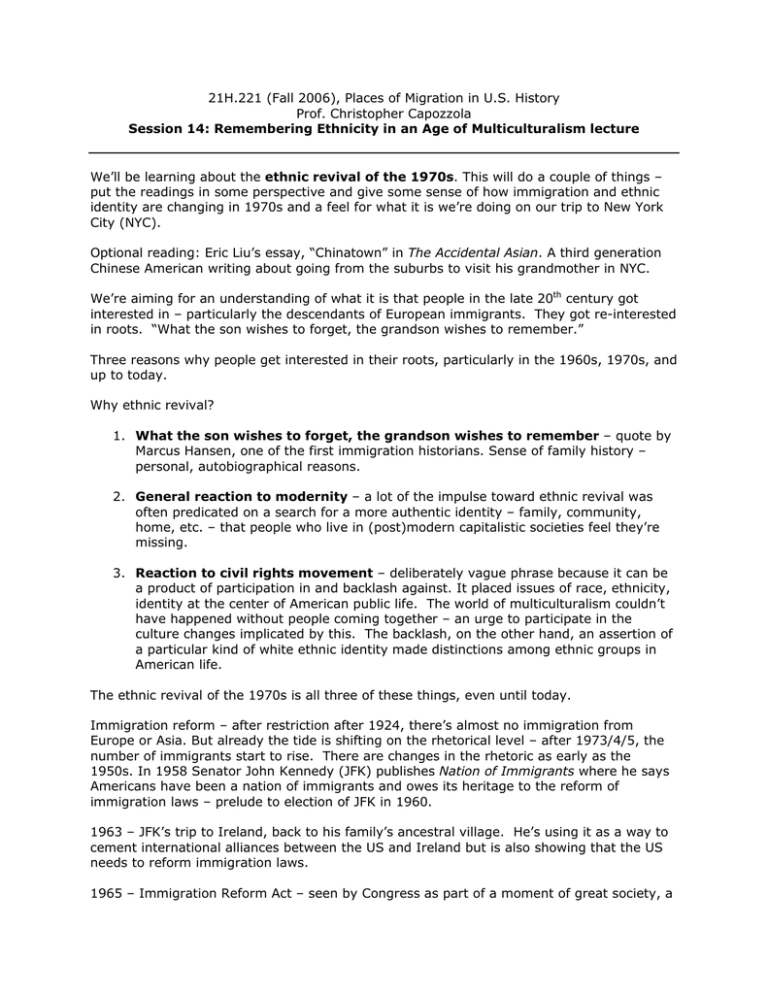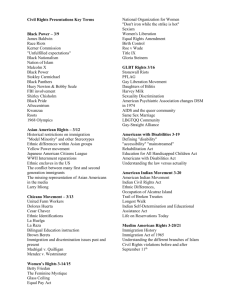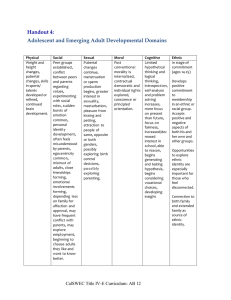21H.221 (Fall 2006), Places of Migration in U.S. History
advertisement

21H.221 (Fall 2006), Places of Migration in U.S. History Prof. Christopher Capozzola Session 14: Remembering Ethnicity in an Age of Multiculturalism lecture We’ll be learning about the ethnic revival of the 1970s. This will do a couple of things – put the readings in some perspective and give some sense of how immigration and ethnic identity are changing in 1970s and a feel for what it is we’re doing on our trip to New York City (NYC). Optional reading: Eric Liu’s essay, “Chinatown” in The Accidental Asian. A third generation Chinese American writing about going from the suburbs to visit his grandmother in NYC. We’re aiming for an understanding of what it is that people in the late 20th century got interested in – particularly the descendants of European immigrants. They got re-interested in roots. “What the son wishes to forget, the grandson wishes to remember.” Three reasons why people get interested in their roots, particularly in the 1960s, 1970s, and up to today. Why ethnic revival? 1. What the son wishes to forget, the grandson wishes to remember – quote by Marcus Hansen, one of the first immigration historians. Sense of family history – personal, autobiographical reasons. 2. General reaction to modernity – a lot of the impulse toward ethnic revival was often predicated on a search for a more authentic identity – family, community, home, etc. – that people who live in (post)modern capitalistic societies feel they’re missing. 3. Reaction to civil rights movement – deliberately vague phrase because it can be a product of participation in and backlash against. It placed issues of race, ethnicity, identity at the center of American public life. The world of multiculturalism couldn’t have happened without people coming together – an urge to participate in the culture changes implicated by this. The backlash, on the other hand, an assertion of a particular kind of white ethnic identity made distinctions among ethnic groups in American life. The ethnic revival of the 1970s is all three of these things, even until today. Immigration reform – after restriction after 1924, there’s almost no immigration from Europe or Asia. But already the tide is shifting on the rhetorical level – after 1973/4/5, the number of immigrants start to rise. There are changes in the rhetoric as early as the 1950s. In 1958 Senator John Kennedy (JFK) publishes Nation of Immigrants where he says Americans have been a nation of immigrants and owes its heritage to the reform of immigration laws – prelude to election of JFK in 1960. 1963 – JFK’s trip to Ireland, back to his family’s ancestral village. He’s using it as a way to cement international alliances between the US and Ireland but is also showing that the US needs to reform immigration laws. 1965 – Immigration Reform Act – seen by Congress as part of a moment of great society, a moment of the civil rights movement more generally. The same congress passes the voting rights act. Immigration reform acts as a symbolic gesture to show that we are a nation of immigrants. Studies done in 1965 suggested that the number of immigrants wouldn’t change very much, but these laws could get racialization and ethniciziation of American institutions out. How all of this works… Thre’s a renovation in American thinking between 1965 and 1990. It’s in these decades that Ellis Island replaces Plymouth Rock as center for American history. Most textbooks or pop culture representations in the mid 20th century place Plymouth Rock as the site of national origins. Ellis Island closed in 1954 and very unceremoniously. From 1954 into the 1970s, it was empty and decrepit, vandalized, not used at all. The government had some ideas of what they’d do with it (e.g. luxury condos, public housing, a dump, something else). In the 1950s when there were plans to develop an American museum of immigration, people turned to the Statue of Liberty not Ellis Island. A marketing firm did studies in 1955, and found only 20% of Americans could identify Ellis Island. Its mythic factor just wasn’t really there in 1955, not as part of our national consciousness. It was made part of the Statue of Liberty national park in 1965 – the same year Lyndon Johnson signs the Immigration Reform Act. No real plans for renovation until 1976 – which was a turning point for many things, such as the American bicentennial. It was a big moment to get Americans to think about their own past – there were localized, community oriented celebrations (since the nation didn’t have money for big fair). Local things fostered senses of community or ethnic heritage. Between 1976 and 1986, the renovation of Statue of Liberty took place. 1986 was the centennial celebration and also renovation celebration – a big 80s celebration. The main person in charge of fundraising was Lee Iacocca, the CEO of Chrysler, himself the son of an immigrant. Chrysler was almost bankrupt in the 1970s but it came back (with government subsidy) – it served as a symbol of American being “back.” Iakoka used money for the renovated Ellis Island that opened in 1990. Now more people visit daily than ever went through on a given day. This is testament to the Americans’ changing understanding of a place like Ellis Island. There was cultural exploration in literature, pop culture, historical research. 1976 = crucial moment. Three influential books were published in 1976 - the best, most respected of the year were: • World of our Fathers by Irving Howe – giant history of the life of Jewish communities of the Lower East Side. Howe grew up in neighborhood and writes of the cultural/ political life of the neighborhood, questions of assimilation. People responded positively, coming at a time when NYC was in tough times, a time of urban decline, so this appealed as a model of NYC in its better days. It’s the idea that “everyone wants a ghetto to look back to.” The Lower East Side is often referred to as the Jewish ghetto. • Woman Warrior by Maxine Hong Kingston – shows how different strands are coming together. Kingston comes out of the culture of ethnic studies and ethnic radicalism and feminism, particularly on the west coast in the 1970s. The book’s about family, memory, community, and draws a lot on history (Chinese-American history of her own family). • Roots by Alex Haley – the book everyone read in 1976. In 1977 it was turned into a TV mini-series watched by 100 million people – a shared national media experience (the country’s population was just over 200 million then). The novel is 21H.221 (Fall 2006), Places of Migration in U.S. History Prof. Christopher Capozzola Session 14 Page 2 of 4 based on his Haley’s efforts at reconstructing his own family history, his ancestors’ passage to America. It encouraged a national boom in family history and genealogy. It’s after 1976 that you start to see ethnic revival kitsch everywhere – e.g. “Kiss me I’m Irish!” or “Parking for Albanians only” for personal driveway, cookbooks (like The Joys of Yiddish and Czech Your Cooking). Movies starting in 1960s are increasingly about the immigration experience – Zorba the Greek (1968), Fiddler on the Roof (1971), The Godfather (1972), Roots (1977). The popular cultural texts are coming along with new historical texts and approaches; the history profession is changing as non-historians have their own interest in history – everyone’s coming together. As late as 1962, the president of the American Historical Association says “many of the young practitioners are products of the lower middle class, emotions get in the way of historical reconstructions” – this was how immigration history was received in 1962. But changes were clearly underway that he was responding to, changes that only accelerated as the 1960s went on – redefining history of war/politics/power to changes of work/labor history. He was also responding to cultural changes in literature and film. They’re making these things possible. Kingston draws on work of immigration historians. Haley couldn’t have written his novel without the work of those working in African American history. Howe is writing history. Philosophers, political theorists, cultural studies folk are all exploring theories of pluralism - cultural relativism, identity politics. There was am excitement that a lot of people brought to this project, with a wide array of people [and their backgrounds] were involved. A lot of what’s going on is a way of participating in the civil rights movement – multiculturalism has a place in it for white ethnic identities, white ethnic European identities. It can also be a backlash against the civil rights movement. The important thing is another 1976 cultural product – the movie Rocky. It’s a poor Italian versus an African American (thinly veiled Mohammad Ali). It’s the standard underdog story classic to boxing movies – interesting that he is this white ethnic underdog. None of this is ever explicit – there’s a sense in which it is this working class white ethnic guy and it matters that he’s a man who is suffering under all of these other things – he’s living in the city at a time when cities are under enormous strain and decay and other social problems. What Rocky taps into even if he doesn’t directly talk about it is this sense of victimhood in which as assertion of a white ethnic identity like his could actually be a backlash/protest against a bunch of things – class differences against white suburbanites fleeing the cities leaving behind the old neighborhood but also against the civil rights movement (conceptualized as an African American movement), or against feminism. His appeal as the underdog is through physicality – through boxing. Historically and even up to now, boxing is an immigrant sport. It’s not the big popular national sport it once was. Boxing used to be deeply divided – the color line was strictly drawn. Rocky appears in theaters at the same time as the Supreme Court ruled on University of California Regents v. Bakke – the case substantially reins in affirmative action as a social policy in 1976. People at the time actually talked about Bakke by comparing him to rocky as this white underdog. In 1984 when Reagan makes his journey to Ireland, one of the songs they play is the theme song for Rocky. The ethnic revival of 1960s and 1970s create places of tourism and pilgrimage – what we’ll be doing when we visit NYC. They are part of a very complicated set of cultural impulses. The fact that Roots and Woman Warrior and Rocky and all these other things can fit on the same list suggest that there are multiple forces going on in the 1970s causing 21H.221 (Fall 2006), Places of Migration in U.S. History Prof. Christopher Capozzola Session 14 Page 3 of 4 people to look back to their past. And it had many different impulses – sometimes competing from different people, conflicting from within. Examples of tension: The conservative writer Michael Novak in the 1970s had an interchange with Native American activist who was criticizing Novak for what his [Novak’s] ancestors had done to his [the Native American activist’s] ancestors. The busing crises in South Boston in 1970s was an example of the ethnic revival of Irish American identity, class wars, racism against African Americans. One of the common signs by white people opposing busing was “England out of northern Ireland, blacks out of South Boston.” The middle and upper class whites of Boston had already left – to suburbs where busing was not going on – so that sense of being the underdog is going on as well. Explorations by historians, writers, particularly in the realm of culture, are very much there in 1970s, but not so much anymore. The ethnic revival wasn’t solely a reaction against the civil rights movement. Paper topics How do you know where to do online research and which resources to choose? Students: - Google scholar - JSTOR - Wikipedia A search on Google for “Lincoln Great Emancipator” yields search result by a holocaust denial organization. It doesn’t seem so at first, but there’s a lesson here to learn. This is also illustrated by how Wikipedia can provide useful knowledge. But the lesson is you should also be critical things of works that show themselves as scholarly work. 21H.221 (Fall 2006), Places of Migration in U.S. History Prof. Christopher Capozzola Session 14 Page 4 of 4







